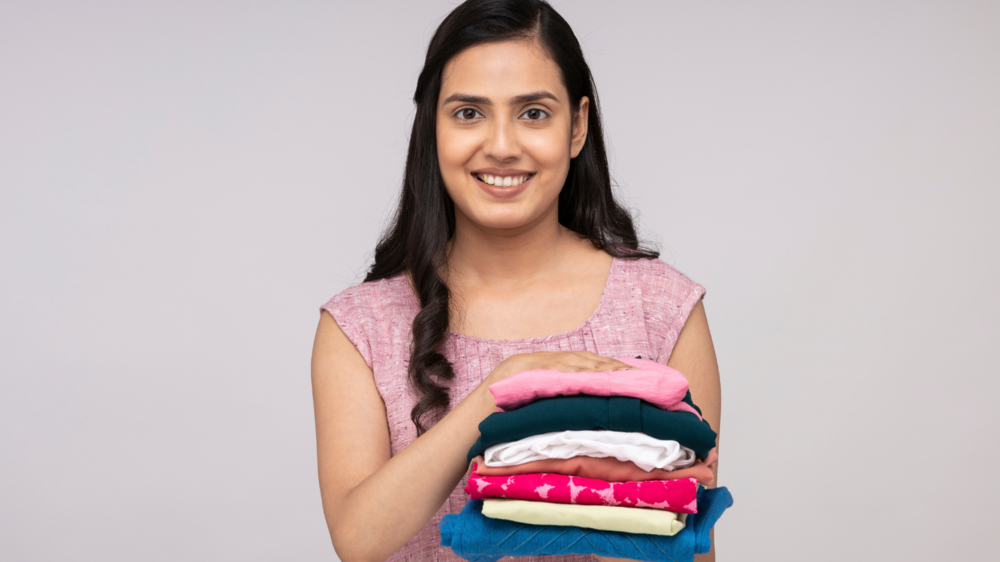In this article:
Why Hospitals Prefer Gowns
Labour is unpredictable. Doctors and nurses may need to act in seconds, and gowns are built for this urgency.Still, it helps to know the medical logic behind the gown:
- Access to your body matters: During labour, checks are frequent: vaginal exams, foetal heart monitoring, blood pressure, IV drips. A gown with ties gives staff quick access. A kurta with leggings delays them when seconds count.
- Infection risks rise in childbirth: Personal clothes, even clean ones, carry detergent residues, dust, or synthetic fibres that can irritate already-sensitive skin. Gowns are sterilised at high temperatures.
- Fluids are unavoidable: Amniotic fluid, sweat, and heavy postpartum bleeding (lochia) can soak through clothing. Gowns are designed to be disposable or industrially washed.
- Emergencies happen suddenly: A normal labour can turn into a C-section in minutes. Gowns make it faster to prepare you for surgery without cutting off clothes.
When Hospitals May Allow Your Own Clothes
Even with strict rules, some private hospitals in India bend for comfort, especially in normal vaginal births. What matters most is whether your clothes meet medical needs.- Fabric choice is critical: 100% cotton or bamboo lets your skin breathe and lowers sweat rashes. Polyester, nylon, or lace traps heat and moisture, raising fungal infection risk.
- Design matters: A loose maternity nightie with front buttons or a maxi dress that lifts easily is often acceptable. Sarees, layered salwars, or jeans are not.
- Simple is safer: No sequins, elastic waistbands, or tight seams. These dig into swollen skin and complicate IV placement.
- Pre-approval helps: Some hospitals ask you to show the outfit during antenatal check-ups. If nurses agree it won’t hinder procedures, you’ll likely be allowed to use it.
What Indian Mothers Commonly Wear
Practical choices reflect both comfort and culture:- Cotton maternity nighties: Popular in India, with zips or button fronts. These double up as breastfeeding wear later.
- Loose maxi dresses: Comfortable in hot wards and easier to move around in during contractions.
- Nursing or sports bras: Some women wear these under gowns for modesty.
- Dupattas or shawls: In mixed-gender wards, many mothers drape a shawl for cultural comfort.
Why Some Mothers Prefer Their Own Clothes
It’s not just vanity. The choice has emotional weight:- Dignity in a vulnerable moment: A familiar outfit helps when your body feels exposed.
- Cultural modesty: For many Indian women, an open-back gown clashes with their upbringing.
- Skin safety: Cotton is less likely to trigger itching, rashes, or fungal infections common in sweaty, humid wards.
- Bonding moments: First photos and skin-to-skin contact often feel more intimate when you’re not in hospital-issued clothes.
The Risks of Insisting on Personal Clothing
Still, there are downsides:- Permanent stains: Lochia can last for weeks and often ruins fabric. Dark cotton may hide stains, but most clothes won’t survive.
- Delays in care: A fitted maxi may take seconds longer to adjust, seconds that matter in foetal distress.
- Hospital refusal: Many government hospitals won’t compromise at all, citing liability and standard protocol.
What About C-Sections?
Here, the rules are clear:- Personal clothes are always removed before entering the operating theatre.
- Sterile gowns are non-negotiable, since even washed clothes can harbour bacteria.
- After surgery and initial monitoring, you can change into your own clothes.
How to Raise the Question With Your Hospital
Don’t wait until contractions to ask. The earlier you discuss, the smoother it will be:- Bring it up at check-ups: Ask about gown rules well before your due date.
- Show examples: Carry one of your maternity nighties and ask the staff if it meets their standards.
- Note hospital type: Private maternity centres are often more lenient; government hospitals are usually strict.
- Put it in your file: If staff agree, have it added to your birth plan.
The Cultural Layer
Clothes mean different things in India than in Western hospitals:- Family presence: Relatives often enter the labour ward briefly. A nightie may feel more comfortable in front of them than a gaping gown.
- Gender sensitivity: For women from conservative families, modest clothing reduces anxiety when male staff are present.
- Photography: Birth photography is growing in Indian metros. Some mothers prefer their own clothes in pictures that will be lifelong memories.
Packing Wisely
If you want the option of personal clothing:- Pack 2–3 dark cotton gowns or maxi dresses. Expect one to be discarded.
- Wash in fragrance-free detergent to reduce skin irritation.
- Bring a hospital gown as backup. Policies may change at the last minute.
- Keep a shawl handy for modesty when staff or relatives enter.
When to Switch to the Hospital Gown
No matter how attached you are to your outfit, switch it if:- Staff struggle to place IVs or monitors.
- The fabric is soaked with blood, sweat, or fluid.
- You feel overheated, itchy, or restricted.
- Doctors say an emergency is unfolding.
Hospital gowns are used for safety. But in India, where cultural modesty matters and family may be present, many women feel strongly about their clothing during delivery. Some private hospitals allow cotton nighties or maxi dresses, provided they don’t hinder care. If this matters to you, ask early, pack wisely, and be ready to switch if safety demands it. At the end of the day, whether in your kurta or a gown, the goal is the same: to bring your baby safely into the world.
Whether you’re pregnant, a new mom, or navigating postpartum, you don’t have to do it alone. Join our support group to connect, share, and support one another.
FAQs on Wearing Your Own Clothes During Delivery: What Hospitals Allow
- Can I refuse a hospital gown?
In India, refusal depends on hospital policy. Private centres may allow cotton nighties; government hospitals generally won’t. - What fabrics are safest for delivery clothes?
100% cotton or bamboo. Both are breathable, hypoallergenic, and minimise sweat rash. - Can I wear my clothes during a C-section?
No. Sterile gowns are mandatory in operating theatres. - Will my clothes be ruined?
Very likely. Heavy bleeding and fluid loss often cause permanent stains. Choose older, dark-coloured cotton garments.











